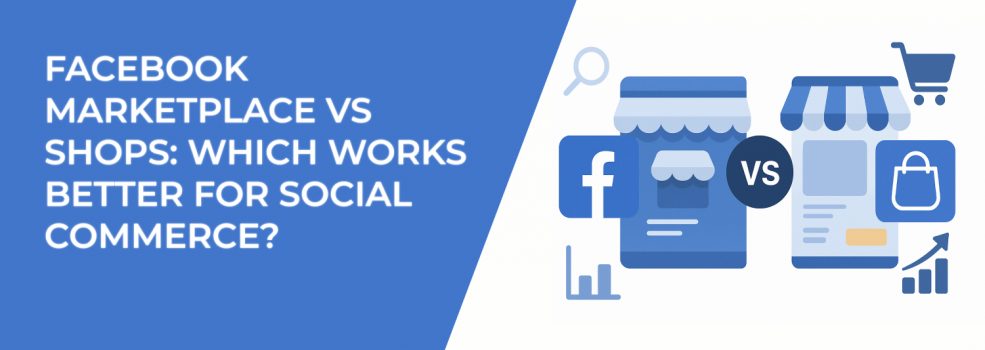Social commerce is growing fast — and Facebook remains one of the most powerful places to connect products with buyers. But if you're a brand or advertiser trying to decide where to sell on Facebook, you’ve probably run into this question:
Should you focus on Facebook Marketplace or Facebook Shops?
Both options live inside the Meta ecosystem. Both can help you drive sales. But they operate in fundamentally different ways — and depending on your goals, one might work much better than the other.
Let’s break it down so you can make the right choice.
What Makes Facebook Marketplace Unique?
Facebook Marketplace feels a lot like a digital yard sale. It's where users scroll through listings, searching for deals, secondhand items, or things they need right now. Many are just browsing. Some are serious shoppers. But one thing is clear — it’s not really built for brands. It’s built for speed and simplicity.
You don’t need a storefront to use Marketplace. You can post a product with just a few clicks. Most listings are created directly from a Facebook profile or business page, without any advanced setup. The experience is stripped down — no collections, no branding, and no customization. Just a title, a few photos, a price, and maybe a short description.
Buyers message sellers directly through Messenger. Transactions often happen offline, and you don’t get analytics or insights about who viewed your products or how they found them.
But that doesn't mean it's useless for advertisers. You can run Facebook ads that appear inside Marketplace — reaching users as they browse. This is especially useful for impulse-friendly products or limited-time offers. Still, it’s a fairly reactive environment. You’re hoping people stumble onto your product while looking for something else.
If you want to dig deeper into how this platform works for brands, check out the complete guide to Facebook Marketplace for businesses.
How Facebook Shops Works Differently
Facebook Shops is a full-fledged eCommerce tool. It’s not just a listing system — it’s a customizable storefront that lives on both Facebook and Instagram. Unlike Marketplace, Shops gives you structure, branding, and tracking. That means you can build a customer journey, not just post a product and wait.
With Shops, you create a centralized space where people can browse your entire catalog, view featured items, and even check out without ever leaving the app (if you choose in-app checkout). It integrates with Meta’s Commerce Manager, letting you track product performance, connect a catalog, and run dynamic ads tied directly to what people have viewed or added to cart.
You can tag products in posts, Stories, and Reels — turning every piece of content into a shoppable experience. You can run ads that automatically pull from your catalog and adjust based on user behavior. And with the Meta Pixel or Conversions API, you can collect detailed performance data and build retargeting audiences.
If you’re ready to turn your Facebook presence into a revenue channel, here’s how to set up a Facebook Shop that actually drives sales.
Need more context? The complete Facebook Shops guide for small businesses covers how to build, brand, and optimize your storefront from day one.
Marketplace vs Shops: Which Performs Better for Marketers?
That depends entirely on what you're trying to achieve. If your goal is to quickly move lower-cost items, especially to local buyers, Marketplace delivers. It’s built for speed, and people there are often actively searching with purchase intent. But you don’t get much control over the experience, and it’s hard to build repeat business.
If, on the other hand, you're thinking about long-term customer value, campaign performance, and optimizing conversions — Facebook Shops is the clear winner. It gives you the tools to measure, tweak, and scale your strategy. You can set up product collections, run catalog sales campaigns, and use insights to make smarter ad decisions over time.
It’s not just about selling a product. It’s about building a repeatable, reliable engine for social commerce — one that integrates with everything else you’re already doing on Facebook and Instagram.
Still not sure which fits your brand better? This article comparing shoppable posts vs Shops can help clarify which setup best supports your content and conversion goals.
3 Smart Ways to Choose Between Marketplace and Shops
If you're not sure where to start, use this framework:
-
Run a small test across both channels.
Pick one product and post it on both Facebook Marketplace and Facebook Shops. Promote each with a modest budget. Track how many people click, engage, or reach out — and more importantly, how many actually buy. Use that data to guide future campaigns. -
Use Marketplace for visibility, and Shops for scale.
You don’t have to choose just one. Start with Marketplace to generate quick interest or local buzz. Then, when someone reaches out or engages, send them to your Shop for a better experience, more product options, and deeper tracking.
This two-pronged approach lets you benefit from Marketplace’s immediacy while still building something more strategic behind the scenes.
So Which Should You Use?
If you’re a casual seller or moving inventory in a local area, Marketplace works just fine. It’s simple, fast, and gets your products in front of people. But if you’re serious about social commerce — if you want to build a system, run ads, and track results — Facebook Shops is the smarter choice.
Marketplace is visibility. Shops is velocity.
And in a competitive landscape where data matters, branding matters, and repeat business matters — Shops gives you more of what actually drives long-term growth.

